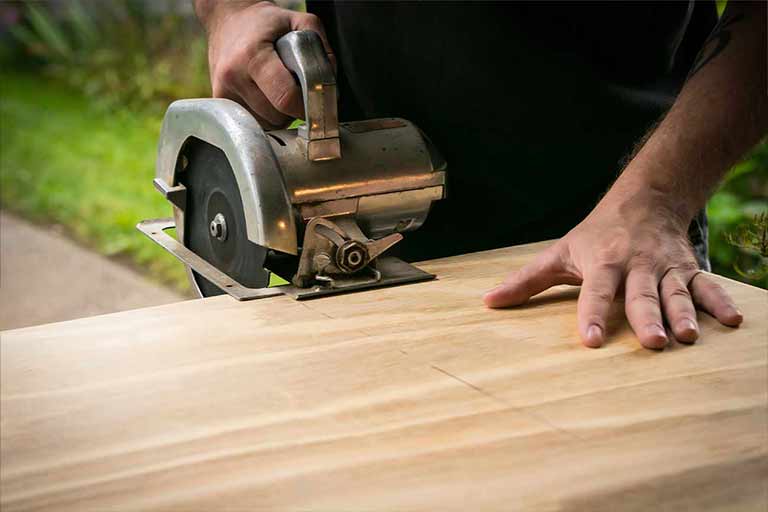
Top Tips for Cutting Plywood Safely and Precisely
Top Tips for Cutting Plywood Safely and Precisely
Are you looking to cut plywood with ease and precision? Whether you’re a professional woodworker or a DIY enthusiast, cutting plywood can be a daunting task. However, with the right tools and techniques, you can cut plywood safely and achieve a precise finish. In this blog post, we’ll share our top tips for cutting plywood safely and precisely.
How to Cut Plywood Precisely?
Cutting plywood precisely is essential for the perfect finish of your project. Here are some top tips to help you achieve precision cutting:
- Measure and mark the plywood accurately before cutting. Use a straight edge and a pencil to mark the line.
- Use a sharp saw blade. A dull blade can cause splintering and rough edges.
- Cut slowly and steadily, letting the saw do the work. Avoid applying too much pressure, which can cause the blade to bend and produce an uneven cut.
- Use a guide to help you cut straight. You can use a straight edge, a clamped board, or a laser guide.
- Consider using a jigsaw or circular saw with a straight edge guide for more precise cuts.
When measuring and marking the plywood, be sure to use a straight edge and a pencil to ensure accuracy. Take your time, as rushing can lead to mistakes that will affect the finish of your project. A sharp saw blade is also essential for precision cutting. A dull blade can cause splintering and rough edges, so make sure your blade is sharp before cutting.
When cutting, let the saw do the work by cutting slowly and steadily. Avoid applying too much pressure, as this can cause the blade to bend and produce an uneven cut. Use a guide to help you cut straight, such as a straight edge or a clamped board. You can also consider using a laser guide or a circular saw with a straight edge guide for more precise cuts.
How to Cut Plywood Straight?
To cut plywood straight, you need to use the right tools and techniques. Here are some tips to help you:
- Use a straight edge guide. You can use a long, straight board or a metal straight edge guide to guide your saw.
- Clamp the plywood to a workbench or table to prevent it from moving during cutting.
- Use a circular saw or jigsaw to cut straight lines.
- Make sure your saw blade is sharp and has the correct number of teeth. A blade with too few teeth can cause splintering, while too many teeth can cause burning.
When cutting plywood straight, using a guide is crucial. You can use a long, straight board or a metal straight edge guide to guide your saw. Clamp the plywood to a workbench or table to prevent it from moving during cutting. Use a circular saw or jigsaw to cut straight lines, and make sure your saw blade is sharp and has the correct number of teeth. A blade with too few teeth can cause splintering, while too many teeth can cause burning.
How to Cut Plywood Without Splintering?
Splintering is a common problem when cutting plywood. Here are some tips to help you cut plywood without splintering:
- Use a sharp saw blade with the correct number of teeth. A blade with too few teeth can cause splintering, while too many teeth can cause burning.
- Apply masking tape to the cut line. The tape will help prevent splintering and give you a cleaner finish.
- Cut with the good side of the plywood facing down. This will help prevent splintering on the good side of the wood.
When it comes to cutting plywood without splintering, using a sharp saw blade with the correct number of teeth is crucial. A blade with too few teeth can cause splintering, while too many teeth can cause burning. Applying masking tape to the cut line can also help prevent splintering and give you a cleaner finish. Cut with the good side of the plywood facing down, as this will help prevent splintering on the good side of the wood.
Tools for Cutting Plywood
Choosing the right tools for cutting plywood is essential for a safe and precise cut. Here are some tools you can use:
- Circular saw: This is the most common tool for cutting plywood. It’s easy to use and can make straight and angled cuts.
- Jigsaw: This tool is ideal for curved and intricate cuts.
- Table saw: This is a powerful tool that can make precise cuts. It’s best suited for larger projects.
- Handsaw: This is a traditional tool that can be used for smaller projects.
- Exacto knife: This is a precision tool that can be used for intricate cuts.
- Blade: The best blade for cutting plywood is one with a high tooth count. This will give you a clean and precise cut.
When it comes to choosing the right tools for cutting plywood, it’s important to consider the size of your project and the type of cuts you need to make. A circular saw is the most common tool for cutting plywood, as it’s easy to use and can make straight and angled cuts. A jigsaw is ideal for curved and intricate cuts, while a table saw is best suited for larger projects. A handsaw is a traditional tool that can be used for smaller projects, and an Exacto knife is a precision tool that can be used for intricate cuts.
The best blade for cutting plywood is one with a high tooth count. This will give you a clean and precise cut, whether you’re cutting film faced plywood, hexa plywood, or any other type of plywood slats. If you’re looking for plywood grades, SFK Plywood offers a range of options, including film faced birch plywood, hexa flooring, UV prefinished plywood, exterior plywood, plywood for deck, UV coated plywood, birch faced plywood, exterior plywood grades, and more.
Cutting Plywood with an Exacto Knife
If you’re looking to cut plywood with an Exacto knife, here are some tips to help you:
- Use a sharp blade. A dull blade can cause splintering and rough edges.
- Use a straight edge or a metal ruler to guide your cuts.
- Cut slowly and steadily, letting the blade do the work.
- Make multiple passes if needed, rather than trying to cut through the plywood in one go.
When cutting plywood with an Exacto knife, using a sharp blade is crucial. A dull blade can cause splintering and rough edges, so make sure your blade is sharp before cutting. Use a straight edge or a metal ruler to guide your cuts, and cut slowly and steadily, letting the blade do the work. If you need to make a deep cut, make multiple passes rather than trying to cut through the plywood in one go.
Choosing the Right Blade for Cutting Plywood
The best blade for cutting plywood is one with a high tooth count. This will give you a clean and precise cut, whether you’re cutting film faced plywood, hexa plywood, or any other type of plywood slats. When choosing a blade, look for one with at least 80 teeth. This will ensure a smooth and clean cut, without splintering or burning the wood.
Cutting plywood can be a challenging task, but with the right tools and techniques, it’s possible to achieve a precise and safe cut. Remember to measure and mark the plywood accurately before cutting, use a sharp saw blade, cut slowly and steadily, and use a guide to help you cut straight. If you’re looking for high-quality plywood, SFK Plywood offers a range of options, including film faced birch plywood, hexa flooring, UV prefinished plywood, exterior plywood, plywood for deck, UV coated plywood, birch faced plywood, exterior plywood grades, and more. Contact us today to learn more about our plywood wholesale, and let us help you find the perfect plywood for your project.






